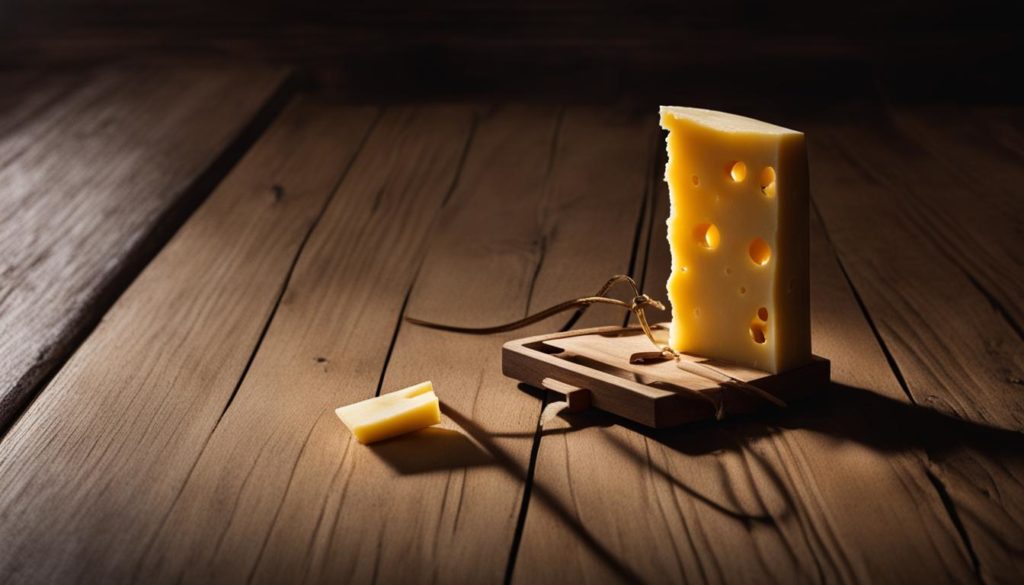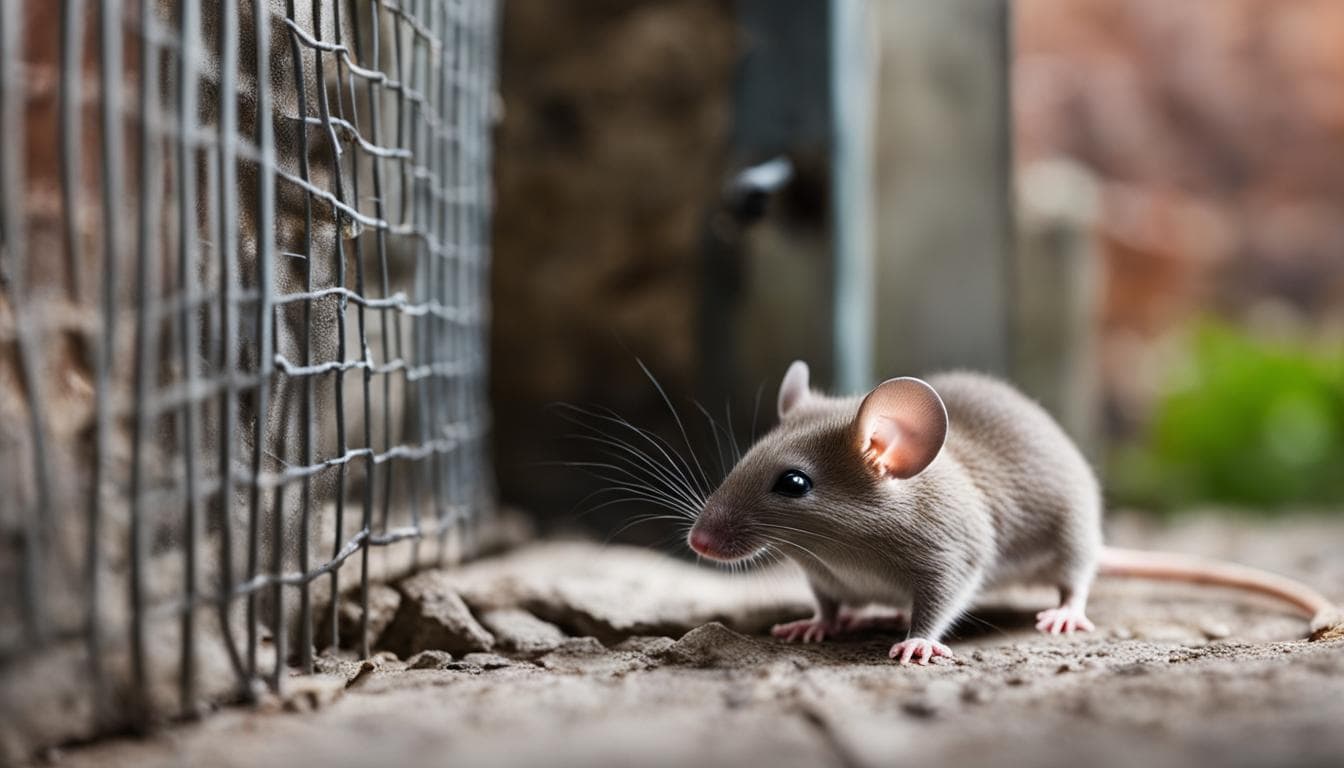Are mice wreaking havoc in your home? Not only can they be a nuisance, but they can also pose serious health risks by carrying diseases. It’s time to take action and mouse-proof your home to ensure a safe and clean living environment for you and your family.
To help you in your endeavor, we have compiled a list of effective home mice proofing tips and solutions. From natural repellents to sealing entry points, these strategies will help you keep those pesky house mice at bay.
Key Takeaways:
- Use steel wool to fill holes where mice can enter.
- Keep your home well-lit to deter mice.
- Consider using peppermint oil as a natural mouse repellent.
- Be cautious when using antifreeze as a bait, as it can be harmful to pets and children.
- Seal potential entry points with silicone caulk to prevent mice from entering.
Spotting a Mouse Infestation and Identifying Signs of Mouse Activity
If you suspect a mouse infestation in your home, it’s crucial to know how to identify the signs of mouse activity. By being aware of these indicators, you can take prompt action to address the problem and prevent further damage or health risks.
One of the most obvious signs of a mouse infestation is the presence of mouse droppings. These small, pellet-like droppings can be found in areas where mice frequent, such as near food sources or along their travel paths. Gnawing damage is another telltale sign, as mice have a constant need to gnaw on objects to keep their teeth sharp and prevent them from growing too long. Look for chew or scratch marks on furniture, walls, wires, and other surfaces.
Mice also leave behind other hints of their presence, such as food crumbs or debris, nests made of fabric or shredded material, and greasy marks from their fur rubbing against surfaces. Dark urine stains and a musty rodent odor are additional signs that mice are active in your home. Pay attention to any squeaks or scratching sounds coming from the walls or ceilings, as these noises often indicate a mouse infestation.
“One of the most obvious signs of a mouse infestation is the presence of mouse droppings.”
Gnawing Damage
Gnawing damage is a common sign of mouse activity. Mice have incisor teeth that never stop growing, so they constantly chew on items to wear down their teeth. Look for gnaw marks on wires, wood, plastic, and even metal. Mice can cause significant damage to your home and belongings if left unchecked.
Aside from physical damage, mice can also pose health risks. They can contaminate food and surfaces with their droppings, urine, and saliva, potentially spreading diseases. It’s important to take immediate action to address a mouse infestation and prevent future incidents.
| Signs of Mouse Activity | Description |
|---|---|
| Mouse droppings | Small, pellet-like droppings found near food sources or along travel paths |
| Gnawing damage | Chew or scratch marks on furniture, walls, wires, and other surfaces |
| Food crumbs or debris | Remnants of food left behind by mice |
| Nests | Fabric or shredded material used by mice to create nests |
| Grease marks | Marks left by mice’s fur rubbing against surfaces |
| Urine stains | Dark stains caused by mouse urine |
| Musty rodent odors | Distinctive smell associated with mouse infestations |
| Sounds | Squeaks or scratching noises coming from walls or ceilings |
Being able to spot the signs of a mouse infestation and identify mouse activity is crucial for effective pest control. By promptly addressing a mouse problem, you can protect your home, belongings, and family from potential health risks and damage.
Natural Ways to Get Rid of Mice in Your Home
When it comes to dealing with a mouse infestation, you may be looking for natural ways to get rid of these pesky rodents. Fortunately, there are several effective methods to eliminate mice from your home without resorting to harmful chemicals or pesticides. By following these natural remedies and taking preventative measures, you can successfully control mice and keep them out of your living space.
Repellents
One of the most effective natural ways to deter mice is by using repellents. There are several options to choose from, including peppermint oil, apple cider vinegar, and hot pepper solutions. These strong scents are known to be unappealing to mice and can help keep them away from your home. Simply mix these ingredients with water and spray them along entry points, corners, and areas where mice are likely to frequent. Reapply the repellents periodically to maintain their effectiveness.
Eliminate Entry Points
Another crucial step in getting rid of mice naturally is eliminating their entry points. Mice are excellent at finding small gaps and cracks in your home’s foundation, doors, and windows to gain access. Use silicone caulk or weatherstripping to seal any openings and prevent mice from entering. Pay close attention to areas such as pipes, utility lines, and vents, as these are common entry points for rodents. By sealing off these potential access points, you can significantly reduce the likelihood of a mouse infestation.
In addition to these methods, it’s important to practice good hygiene and sanitation in your home. Keep your living space clean, store food in airtight containers, and remove any potential sources of food or nesting materials that may attract mice. By combining these natural remedies and preventative measures, you can effectively get rid of mice and maintain a mouse-free environment in your home.
| Method | Effectiveness | Benefits |
|---|---|---|
| Peppermint oil | High | Natural and safe |
| Apple cider vinegar | Medium | Affordable and readily available |
| Hot pepper solution | Low | Natural repellent |
| Sealing entry points | High | Prevents new infestations |
Preventing Future Mice Infestations
Mice can be persistent creatures, always looking for ways to invade your home. To keep them at bay and prevent future infestations, there are several steps you can take to seal off entry points and make your home less attractive to these unwanted guests.
Seal Off Entry Points
The first line of defense against mice is to seal off any potential entry points in your home. Mice can squeeze through tiny gaps and cracks, so it’s essential to inspect your home thoroughly. Use caulk to fill small holes and cracks in your home’s structure, paying close attention to areas around pipes, vents, and utility lines. Repair broken windows and doors and install door sweeps to prevent mice from slipping through gaps at the bottom.
Prune Branches from Your House
Mice are excellent climbers and can use tree branches and shrubs to gain access to your home. Keep them at a safe distance by pruning branches that are close to your house. Trim back landscaping plants and shrubs to eliminate potential hiding spots for mice. By creating a clear space between your home and surrounding vegetation, you reduce the chances of mice finding their way in.
| Preventive Measures | Description |
|---|---|
| Seal off entry points | Use caulk to fill small holes and cracks in your home’s structure, repair broken windows and doors, and install door sweeps. |
| Prune branches from your house | Trim back branches and shrubs that are close to your house to eliminate potential access points for mice. |
By taking these preventative measures, you can greatly reduce the risk of future mice infestations in your home. Remember to stay vigilant and address any potential entry points promptly to keep your living space mouse-free.
Setting Mouse Traps for Effective Mouse Control

When it comes to controlling mice in your home, setting mouse traps is a tried and true method. By strategically placing traps in areas where mice are active, you can effectively catch and remove these unwanted pests from your living space. There are different types of traps available, each with its own advantages and considerations.
Snap Traps: Snap traps are widely available and affordable. They consist of a spring-loaded bar that snaps shut when a mouse triggers the trap. Snap traps are highly effective when set correctly and can quickly eliminate mice.
Automatic Multiple Catch Traps: If you’re dealing with a larger infestation, automatic multiple catch traps can be a useful option. These traps allow you to catch multiple mice without having to reset the trap each time. Once caught, you can release the mice far away from your home to ensure they don’t return.
Glue Traps: While glue traps can be effective, they are considered less humane as they can cause prolonged suffering for mice. Additionally, other animals or pets may accidentally get stuck in the glue.
Live Traps: Live traps are another option, but it’s important to check local regulations before using them as they may not be legal in all areas. With live traps, you can catch mice without harming them and then release them at a suitable location.
Remember to bait your traps with high-interest foods like peanut butter or cheese to attract mice. Place the traps strategically along walls, near trash cans, or in areas where mouse activity has been observed. Regularly check the traps and dispose of any caught mice properly.
| Trap Type | Advantages | Considerations |
|---|---|---|
| Snap Traps | Widely available and affordable | Can be dangerous if not handled properly |
| Automatic Multiple Catch Traps | Allows for catching multiple mice without resetting | Requires regular checking and releasing of caught mice |
| Glue Traps | Can be effective in catching mice | Considered less humane and can capture unintended animals |
| Live Traps | Catches mice without causing harm | Check local regulations for legality |
“Setting mouse traps strategically is key to successful mouse control. Place traps where mice are active and use high-interest baits to attract them. Regularly check and dispose of caught mice to maintain a pest-free home.”
– Pest Control Expert
Conclusion
Congratulations on taking steps to mouse-proof your home and tackle the pesky problem of mouse infestation! By implementing these DIY mouse control methods, you can effectively manage small infestations and protect your home and family from the diseases mice can carry.
However, it’s important to recognize that severe mouse infestations may require professional pest management. If your DIY efforts have failed or if the problem persists, it’s wise to seek the assistance of trained professionals who have the knowledge and expertise to handle the situation effectively.
Remember to follow safety precautions when using pesticides or traps, and properly dispose of any dead mice you encounter. Additionally, focus on preventing future mouse infestations by maintaining proper sanitation practices and diligently sealing off any potential entry points in your home.
By combining DIY mouse control methods with professional pest management, you can successfully eliminate mice from your property and enjoy a pest-free home environment.
FAQ
What are the signs of a mouse infestation?
Signs of mouse activity include chew or scratch marks, gnawing damage, food crumbs or debris, mouse droppings, nests made of fabric or shredded material, mouse runways, grease marks, dark urine stains, musty rodent odors, and squeaks and scratching sounds.
How can I naturally get rid of mice in my home?
Getting rid of mice naturally starts with removing their sources of food and shelter. Use natural repellents like apple cider vinegar and water or a hot pepper solution. Eliminate entry points by sealing gaps and cracks in your home’s foundation, doors, and windows.
How can I prevent future mice infestations?
To prevent future mice infestations, seal off entry points by using caulk to fill small holes and cracks in your home’s structure. Repair broken windows and doors, and install door sweeps. Keep shrubs, trees, and landscaping plants trimmed back to eliminate hiding spots for mice.
What is the best way to set mouse traps?
Setting mouse traps is an effective method of controlling mice. Bait traps with high-interest foods like peanut butter or cheese. Place traps strategically in areas where mice are active, such as along walls and behind trash cans.
Should I hire professional pest management for a severe mouse problem?
DIY mouse control methods can be effective for small infestations, but for severe or persistent mouse problems, it is advisable to consider professional pest management. Safety precautions should be followed when using pesticides or traps, and proper disposal of dead mice is important.
Source Links
- https://www.goodhousekeeping.com/home/cleaning/a35872/how-to-get-rid-of-mice/
- https://bestlifeonline.com/mouse-prevention/
- https://smithspestmanagement.com/blog/post/how-to-get-rid-of-mice/

Welcome to micegoneguide.com, your go-to resource for eliminating rats and mice. Say goodbye to rodent infestations with our expert tips and strategies. Visit us now and reclaim your space!

